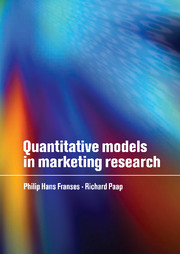Book contents
- Frontmatter
- Contents
- List of figures
- List of tables
- Preface
- 1 Introduction and outline of the book
- 2 Features of marketing research data
- 3 A continuous dependent variable
- 4 A binomial dependent variable
- 5 An unordered multinomial dependent variable
- 6 An ordered multinomial dependent variable
- 7 A limited dependent variable
- 8 A duration dependent variable
- Appendix
- Bibliography
- Author index
- Subject index
8 - A duration dependent variable
Published online by Cambridge University Press: 06 July 2010
- Frontmatter
- Contents
- List of figures
- List of tables
- Preface
- 1 Introduction and outline of the book
- 2 Features of marketing research data
- 3 A continuous dependent variable
- 4 A binomial dependent variable
- 5 An unordered multinomial dependent variable
- 6 An ordered multinomial dependent variable
- 7 A limited dependent variable
- 8 A duration dependent variable
- Appendix
- Bibliography
- Author index
- Subject index
Summary
In the previous chapters we have discussed econometric models for ordered and unordered discrete choice dependent variables and continuous dependent variables, which may be censored or truncated. In this chapter we deal with models for duration as the dependent variable. Duration data often occur in marketing research. Some examples concern the time between two purchases, the time until a customer becomes inactive or cancels a subscription or service contract, and the time it takes to respond to a direct mailing (see Helsen and Schmittlein, 1993, table 1, for more examples).
Models for duration data receive special attention in the econometric literature. This is because standard regression models cannot be used. In fact, standard regression models are used to correlate a dependent variable with explanatory variables that are all measured at the same point in time. In contrast, if one wants to relate a duration variable to explanatory variables, it is likely that the duration will also depend on the path of the values of the explanatory variables during the period of duration. For example, the timing of a purchase may depend on the price of the product at the time of the purchase but also on the price in the weeks or days before the purchase. During these weeks a household may have considered the price of the product to be too high, and therefore it postponed its purchase. Hence, the focus of modeling of duration is often not on explaining duration directly but merely on the probability that the duration will end this week given that it lasted until this week.
A second important feature of duration data is censoring.
- Type
- Chapter
- Information
- Quantitative Models in Marketing Research , pp. 158 - 183Publisher: Cambridge University PressPrint publication year: 2001



